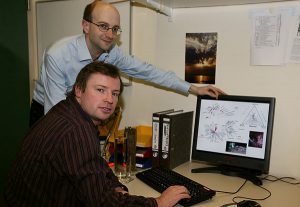Whale bones and farm soil: Sequencing biodiversity
Scientists use metagenomics to characterize the invisible life in various environments
Instead of sequencing the genome of one organism, why not sequence a drop of sea water, a gram of farm soil or even a sunken whale skeleton? Scientists at the European Molecular Biology Laboratory (EMBL) in Heidelberg and their US collaborators have done just that, and the result is a new appreciation for the rich diversity of life that exists in the most unlikely places (Science, April 22, 2005).
Bacteria make up the greatest mass of life on earth by far and play a crucial role in the lives of all other organisms. But scientists have only touched the tip of the iceberg when it comes to identifying bacteria – 99% of species cannot be grown by standard techniques in the laboratory. The emerging field of ‘metagenomics’ is rapidly giving researchers a view of how diverse microbial life really is. Instead of analyzing the genome of a specific organism, scientists sequence the DNA from environmental samples such as the ocean or soil. For the first time, this gives them a clear picture of the diversity of life in these habitats.
“These studies were simply not possible before,” says Peer Bork, the EMBL scientist responsible for the data analysis in the project. “And future applications for this type of technology are endless, from giving farmers insight into their soil to fighting bacterial contamination in hospitals to characterizing microbes in a patient’s mouth.”
In the current study, Bork worked with EMBL scientist Christian von Mering and US collaborators to analyze two very different samples: whale skeletons from the bottom of the ocean floor and soil from a farm in the USA. Sunken whale skeletons are a lipid-rich nutrient source that can foster the growth of a flourishing ecosystem that contains specialized bacteria, whereas soil is an example of a complex microbial environment that can contain more than 3000 distinct species (most of them bacterial) in a half-gram sample.
The scientists started by sequencing hundreds of thousands of genes from each sample Æ the DNA equivalent of about 50 complete bacterial genomes. This data was then complemented by two recently published data sets from studies on surface water and on acidic underground mine water, enabling for the first time a comparative study of life in four different habitats.
From the genes in each environmental sample, scientists constructed a ‘functional fingerprint’ of each habitat. These fingerprints revealed that the way in which each bacterial community had adapted to different environmental conditions was reflected in its genetic material. Different classes of genes were found to be specifically enriched in each environment, for example enzymes that break down plant material in the soil sample or photosynthetic genes in the surface water. Apart from known genes, the scientists also found many new environment-specific genes whose function was not previously known. Often, they could predict their broad functional class from the gene’s location in the DNA fragment. In soil, for example, many novel genes were predicted to be involved in DNA repair and in the biosynthesis of antibiotics.
“Although only a limited number of pieces of the puzzle have been revealed through the many thousands of fragments of DNA from different organisms, they are sufficient to capture differences between the communities from genome sizes to lifestyle,” Bork says.
This type of approach could provide more information on environments about which little is known – permitting estimates of the nutrient supply in the soil or pollution levels in the sea. The data may also be used as the starting point for estimating the total number of species on earth, as well as the number of cellular processes that make life so complex.




